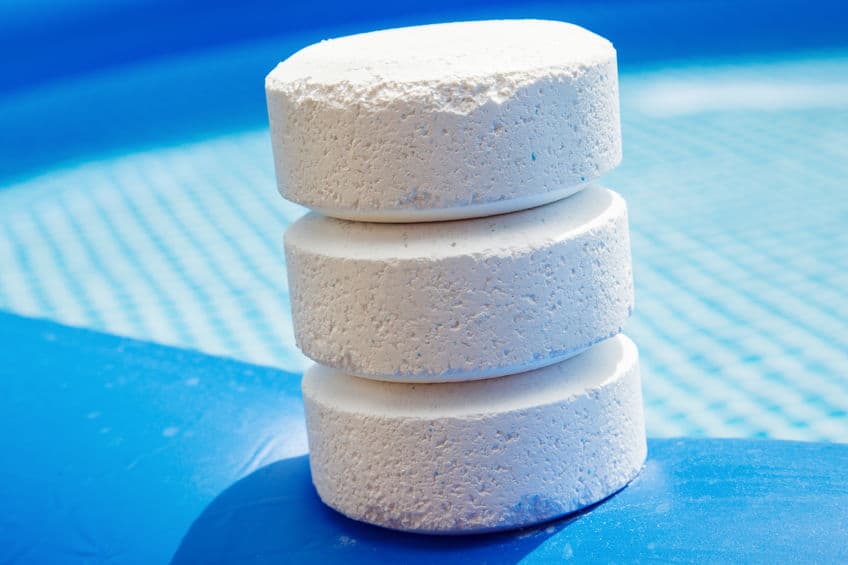Salt water pools have chlorine in them just like regularly chlorinated pools. While a salt water pool uses a salt water chlorinator to produce chlorine, a regular chlorine pool requires manual addition of chemical product each week to sanitize the water.
But do salt water pools have less chlorine than other types of pools or do they have more? There is conflicting information online mostly from people who seemingly have never owned a pool let alone a salt water one.
Salt water pools and regular chlorine pools both require a chlorine level of 1 ppm – 3 ppm. A salt chlorinator produces chlorine at a slow and steady rate whereas chemically chlorinated pools can have chlorine spikes when added quickly in large amounts. The total free chlorine in both pools however should be the same.
It’s a misnomer to suggest that salt water pools have lower chlorine levels than regularly chlorinated pools but the answer is a bit more complex, given how the chlorine is added to the pool in each case.
Below we’ll delve into how salt water pool and regularly chlorinated pools compare in terms of the chlorine itself.
Do salt water pools have less chlorine in them than regular chlorine pools?
The generally accepted chlorine requirement for both salt water and regularly chlorinated pools is 1 ppm – 3 ppm although the Association of Pool and Spa Professionals suggests a slightly higher level of 2 ppm – 4 ppm for both swimming pools and spa pools.
The Center for Disease Control (CDC) recommend swimming pools maintain a chlorine level over 1 ppm.
So if you keep your chlorine level within the 2 ppm – 3 ppm range, you’re satisfying all the major organizations’ recommendations.
A salt water pools = a chlorinated pool
You might be surprised to learn that salt water pools have chlorine in them at all. It’s a common misconception but salt water pools are chlorine pools. Further, salt water pools require the same level of chlorine in them as regular, old style chlorine pools do.
And why wouldn’t they?
Since chlorine is the sanitizing agent, what would make a salt water pool require less chlorine than a pool sanitized with chemical chlorine?
The answer is, they require the same level of chlorine in order for you to have crystal clear water for swimming. In a salt water pool, salt is the catalyst required in conjunction with the salt chlorinator to produce the necessary chlorine.
That’s the main difference: How the chlorine is delivered.
What pool has a higher concentration of chlorine at any given time?
This question needs some explanation:
Regular chlorinated pool
Regularly chlorinated pools rely on the pool owner to manually add chlorine on a regular basis, perhaps every few days or once per week. They might use a variety of chlorine products:
- Chlorine Shock – Highly concentrated in small packs and the most expensive.
- Liquid chlorine – Expensive and sold in large buckets but quick to use.
- Compact chlorine pucks – Easiest to use, slow release, medium level of price.
- Crystal chlorine – Least expensive by weight when sold in large buckets but requires mixing with water.
When liquid or powder chlorine is added in a large amount as with crystals and Shock, it is dumped in and quickly gets circulated. So it stands to reason that there can be a chlorine spike upwards given the large injection of chlorine in a short period of time.
Pucks are slow release products so they dissolve in the side skimmer over time, meaning there is less chance of a chlorine spike.
In that regard, it’s often recommended to wait upwards of 4 hours (check the product instructions) after you’ve added chlorine, before swimming again.
Salt water pool
A salt water pool uses a salt chlorinator to produce a slow but steady level of chlorine. You can set the system (depending on your chosen chlorinator brand and model) to produce a percentage of the time that the pool pump is running.
But the pump also has to be running for the chlorinator to produce chlorine. So you have some control of how much chlorine is produced.
On top of that, a chlorinator can typically produce no more than 1.47 lbs of chlorine per day (select Hayward products) but that’s assuming you run the pump 24/7 and the chlorinator at 100%, which no one does!
So with a salt chlorination system, the addition of chlorine is slower than the quick bump you can get by adding chemical chlorine.
What’s better: A salt water pool or regular chlorine pool?
A salt water pool is a good choice if you don’t mind spending more money up front on the chlorination system but desire a pool with slightly less maintenance and upkeep and prefer chlorinated water that is easier on your skin, eyes and hair.
A regularly chlorinated pool is fine if you want to spend a little bit less money and are ok with more maintenance since you have to manually add chlorine. Having said that, there are now chlorine dosing machines available that meter out chlorine and add it automatically rather than you doing it.
Summary
Salt water pools and regularly chlorinated pools require the same level of chlorine to function properly and remain sanitized: 1 ppm – 3 ppm. Salt water pools generally require less maintenance than regular chlorine pools and it’s often easier to maintain pool water chemistry with salt water pools too.
One final thing to consider: A salt water pool can also use chemical chlorine from time to time (pool opening and closing, to shock the system). Check out my article Is It OK To Put Chlorine Tablets In A Saltwater Pool? (Explained) to learn more.

